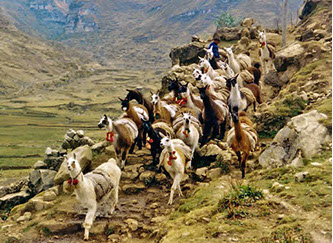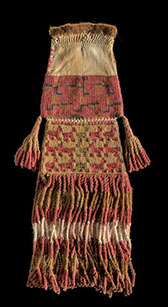

However visitors wind their way through the Smithsonian’s Inka Road exhibition, they’ll find insights in the technology, history and art of that ancient South American civilization.
technology, history and art of that ancient South American civilization.
Spanish conquistadores described the Inka Road as “one of the great constructions the world has ever seen.” Five hundred years later, UNESCO classified it as a World Heritage site. Now, the road is showcased in The Great Inka Road: Engineering an Empire at the National Museum of the American Indian (NMAI) in Washington, D.C.
A simulated “flyover” of a segment of the road system lets visitors to the exhibition visualize its magnitude, complexity and enormous scale. It’s difficult not to compare it to the U.S. interstate highway system, a 45,000-mile network that has taken decades to build at a cost of $485 billion.
By any standard, the road is an engineering marvel, a 24,000-mile network crosscrossing most of western South America. Much of the road construction work was likely done as part of a labor tax, but how huge stones for paving and walls were quarried and transported without wheeled vehicles, heavy draft animals or iron tools still confounds the imagination. A contemporary Quechua elder notes, “We don’t know anymore how they made such a road.”
 “The Inka are one of the primary examples of the achievements of the indigenous people in the Western Hemisphere,” said NMAI diector Kevin Gover. “Their knowledge, their understanding of their environment, their agriculture and, of course, their engineering all remain infinitely interesting and instructive.”
“The Inka are one of the primary examples of the achievements of the indigenous people in the Western Hemisphere,” said NMAI diector Kevin Gover. “Their knowledge, their understanding of their environment, their agriculture and, of course, their engineering all remain infinitely interesting and instructive.”
Among the great engineering challenges the Inka overcame constructing the road through mountains, desert, rain forest and grasslands was spanning canyons and valleys. Employing the same principles as modern suspension bridges, they built and maintained hanging bridges woven from grasses that could support 5,000 pounds. A key element of the exhibition is a scale-model of the bridge building technique. Equally impressive were the drainage systems the Inka developed to control erosion along the road.
The exhibition traces the history of the Inka Empire and explores how the road facilitated its growth. From a small kingdom based in Peru in the 13th century, the Inka added territory that by time of the Spanish conquest in 1530s spanned much of modern-day Peru, Chile, Colombia, Ecuador and Bolivia.
As the Inka Empire expanded, the road enabled the Cusco-based rulers to acquire resources from neighboring territories. All roads led to Cusco, but the most familiar part of the Inka Road that runs from Cusco to Machu Picchu is barely one per cent of the highway’s expanse.
Royal processions, herds of llamas and messengers traversed its length. Way stations were built every 12 to 15 miles along the road, roughly a day’s journey by foot. The road was also lined with storage houses for surplus grains and altars to the sun god.
Visitors to the exhibition can get a sense of how the road served as a communications system with access to the entire empire by playing an interactive game that lets them manage the routing of the relay messengers who carried information throughout the empire via the Inka Road. Lacking a writing system, the Inka messengers relied on the khipu, a memory device made of knots on colored string. Another of the interactive displays in the exhibition shows visitors how to read khipus.
Ironically, the road, which had so successfully united the vast Inka Empire, also facilitated its conquest by the Spaniards. Their horses and wheeled carts destroyed much of the road intended for messengers and llamas. Nonetheless, portions of the road are still in use, incorporated into the Pan American Highway.
An unheralded aspect of the exhibition is the opportunity to view an extensive selection of the museum’s Pre-Columbian Inka artifacts. Most of the 140 objects on display are from NMAI’s own collection. Among them are a ceramic Chavín stirrup spout bottle (the oldest item in the exhibition, ca. 800–100 B.C.), impressive gold ornaments, necklaces made from shells from the Lambayeque region, stone carvings, silver and gold figurines, and various textiles made from llama and alpaca hair and cotton. A personal favorite is an Inka silver jar for chicha—fermented corn beer—with ears of corn supporting a bowl in the shape of a human face.
The Great Inka Road: Engineering an Empire will be on display at the Smithsonian Institution’s National Museum of the American Indian in Washington, D.C. through June 2018.
John Coppola